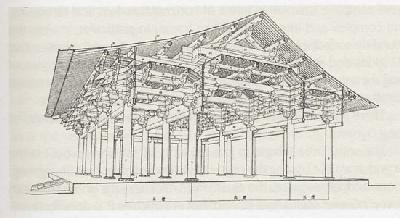 |
The composition of the space represents a major characteristic distinguishing architectural art from other plastic arts. The hall of Foguang Temple provides us with the only important example for understanding the internal space of Tang Dynasty structures. The core space is fairly high. The walls and Buddhist altar between pillars also give prominence to its important position. Around the check-shaped ceilings are slanting rafters, under which are thoroughly exposed beam frames. These beam frames are both necessary structural members and an important means of expressing the structural beauty and dividing the space. Between the wooden structural members of the beam is vacuum .The space between makes "circulation" possible, which is empty, bright and permeable. The grandiose beam frame and the dense checks of the ceilings form the contrast between the coarse and the fine, and the sense of weight. The low and narrow peripheral space serves as a foil to the center space. But the designing methods for the beam frame and the ceiling are identical. The entirety is accomplished at one stretch giving a strong sense of order. All spaces of different sizes try hard to avoid complete isolation in terms of horizontal and vertical directions. The complex and interwoven beam frame, in particular, makes the boundary surface of the space hazy and implicit, without the least sense of rigidity and stagnation.
This example demonstrates that artisans of Tang Dynasty architecture already had a high degree of self-conscious spatial esthetic judgment and superb spatial handling technique.
